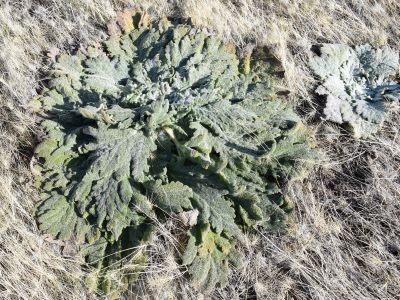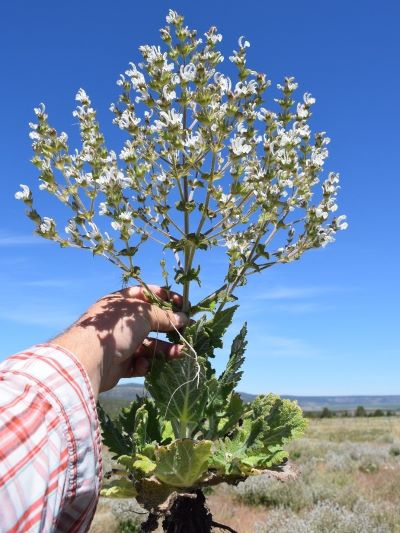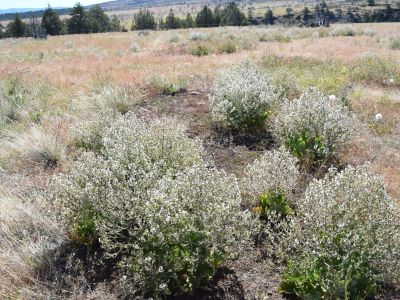Mediterranean sage (Salvia aethiopis)
By Tom Getts, Weed Ecology and Cropping Systems Advisor, University of California Extension
Introduction

Photo; Tom Getts
Mediterranean sage (Salvia aethiopis L.), or “Med sage,” is a unique invasive weed in the mint family. What is not unique about Med sage is that it shares the native range of Eurasia with numerous invasive weeds in western North America. This species is considered noxious in many western states including California, Colorado, Idaho, Nevada, Oregon, and Washington. While it has not been found in Montana, it has been reported in 11 counties in Idaho, including both Clearwater and Idaho Counties which share a border with Montana.
Identification
Med sage is a biennial or short-lived perennial species. It has very distinctive foliage and flowers, making it noticeable on the landscape. Leaves are of a bluish tinge, covered in thick white hairs, and produce a sage-like odor when crushed. Leaves are almost fleshy and similar to common mullein leaves; however, the hue is bluer with semi-serrated wrinkled edges. During its first year Med sage forms a rosette. In the second year it will bolt to 1 to 3 feet tall in early summer producing a large mass of beautiful, irregular white flowers that can attract many pollinators.

Photo; Tom Getts
Biology, Ecology, and Impacts
Med sage reproduces only by seed. Upon maturity the plant turns brown and breaks off at the soil surface turning into a tumbleweed and effective seed distributor. Seed production is prolific ranging from 50 to 100 thousand seeds per plant, which are thought to live for multiple years in the soil. Med sage can form monocultures crowding out desirable species on rangelands, especially in areas that are heavily grazed or disturbed. It thrives in areas that are dryer or have a lighter textured soil. It is unpalatable for livestock, and in a pasture setting it will often outcompete desirable plants. It can even eke out a living in dense stands of invasive annual grasses, although plant size will be stunted from competition. Generally, it is not found or is not problematic in crop production systems as it is controlled by tillage.
Management
Like many biennials, mechanical control methods, such as hand pulling or cutting the root below the soil surface, are very effective in the rosette stage. Dense competitive vegetation can be a good way to suppress populations. A root feeding weevil (Phrydiuchus tau) has been effective at reducing Med sage populations in some areas but has been ineffective in areas under grazing or disturbance. For herbicide control options, 2,4-D, aminopyralid, clopyralid, dicamba, picloram, glyphosate, chlorsulfuron and metsulfuron all have activity. Generally small rosettes are easier to kill and require lower rates of herbicide. Early bolting plants can be controlled with many of the listed herbicides at higher rates. Because of the dense hairs, the addition of a good surfactant to break the surface tension of the spray is important to get absorption of the herbicide into the leaf. Whenever using an herbicide always read and follow the herbicide label.

Photo; Tom Getts
Further Information
For more information about this month's weed post, contact Associate Extension Specialist Noelle Orloff. Past posts are available in the Monthly Weed Post Directory.
This weed post is also available as a printable PDF (413 KB).
